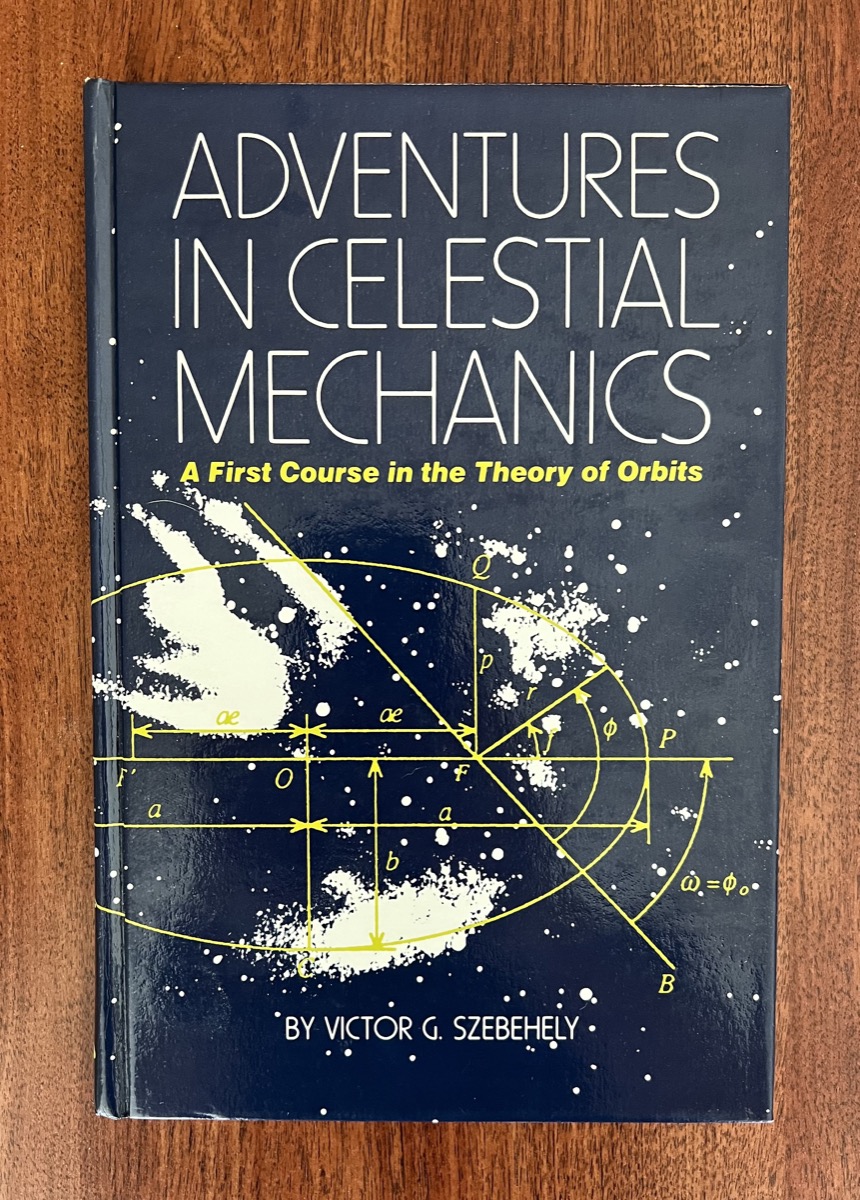Gravitational potential energy
April 16, 2024 at 5:28 PM by Dr. Drang
One of the things I planned to do upon retirement was study topics that I had missed, or nearly missed, in school. Some of these would be things that were barely touched on in class; some would be material that was in the textbook but not covered in class; and some would be topics that were adjacent to the classes I took. When I was just out of school, I thought I’d be able to start following up on these topics pretty much right away. And if you allow for an elastic definition of “pretty much right away,” I’m on schedule.
My first topic is orbital mechanics, and the textbook I’ve chosen is Victor Szebehely’s Adventures in Celestial Mechanics, published in 1989 by the University of Texas Press.

As textbooks go, it’s fairly thin at 175 pages, and the math is pretty elementary—a good book to start with, I think. I’m seven chapters in and taking a little break to review what I’ve learned so far. I’m treating this as if I were in class and Szebehely was using the text as his lecture notes. In other words, I’m not just reading the book; I’m going through all the derivations and solving all the problems. If I wanted a shallow understanding, I’d just watch a few Neil deGrasse Tyson videos on YouTube and call it a day.1
One of the things I found odd about Szebehely’s approach is that he never derives—or even presents—the expression for gravitational potential energy. I decided to do it myself and then write it out here, so I could find it easily.
In outline, the derivation works this way:
- We start with Newton’s Law of Universal Gravitation to get the force between two bodies.
- We then determine the work done by that force as the distance between the bodies changes.
- Finally, we use the relationship between work and energy to get an expression for the gravitational potential energy.
The force of gravity between two bodies is
where and are the masses of the two bodies, is the distance between their mass centers, and is the universal gravitational constant,
This force acts on each body in the direction of the other body, so the work done by gravity as the distance between the bodies changes from to is2
The minus sign is there because the force acts in the opposite direction of the distance increment, .
Carrying out the integration, we get
The work and energy principle says
where is the change in potential energy, i.e.,
The negative sign in the work-energy equation comes from what potential energy is all about: the potential to do work. If a force does positive work, its potential to do further work has decreased.
Putting this together, we get
Sorting out the negative signs, we see that
and
so our expression for gravitational potential energy at any distance, , is
If you’re worried about the negative sign in this expression, don’t be. Recall from your first course in physics that it’s the change in potential energy that matters, not the value at any given position. The key thing to note about this expression is that increases as increases, which is how it should be.
Well, that didn’t take too long. Let’s expand on this solution. You might also remember from physics class that the potential energy of a body of mass near the surface of the Earth is
where is the elevation of the body and is the acceleration due to gravity. How does this expression compare to what we just derived?
First, let’s rewrite our expression for to specialize it for a body near the surface of the Earth:
where is the mass of the Earth.
Because the body is close to the surface of the Earth, we’ll expand our expression for in a Taylor series about , the radius of the Earth. That will be
The further terms in the expansion will have higher derivatives of , higher powers of , and be divided by higher factorials.
Since
and so on, the expansion works out to
where the further terms will be multiplied by higher powers of and divided by higher powers of . Note that the factorials get canceled by the coefficients of the derivatives. Also, we get alternating signs because of the alternating signs of the derivatives.
At this point, we recognize that is the distance above the Earth’s surface, which is . And because we care only about the change in potential energy with changes in , we can drop the constant initial term. So if we collect the common terms, we get
Since , the term in parentheses is approximately one, and
Is the term in the parentheses equal to ? According to NASA
and
Plugging in those values and the value of we saw earlier, we get
which is pretty close to the textbook value for the acceleration due to gravity, .
But shouldn’t it be closer? We have enough digits in our values for , , and that we shouldn’t be off in the third digit of . What are we missing? Mainly that the Earth is spinning. The centrifugal effect on the surface of the Earth is small, but it’s the primary reason for the difference between and .
-
There’s a place for Neil deGrasse Tyson videos, but that’s not where I want to go. ↩
-
Strictly speaking, the integrand of the work expression is the dot product of the force vector and the distance increment vector, but for gravity those two vectors are parallel, so we can get by with scalar terms. ↩
